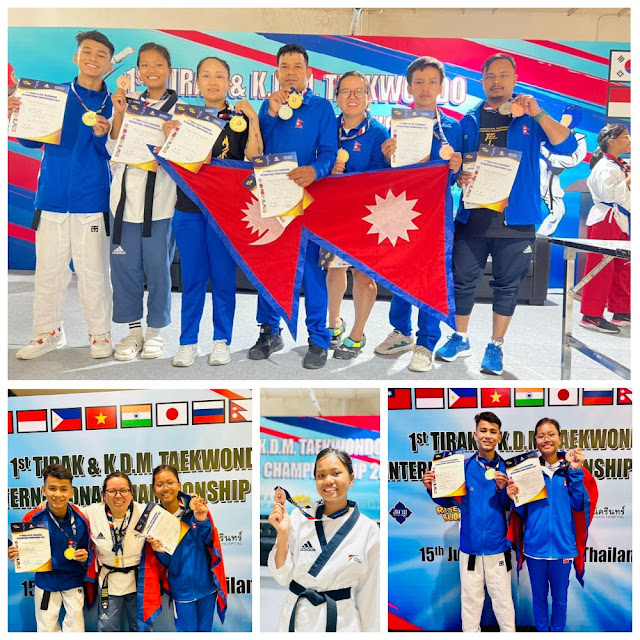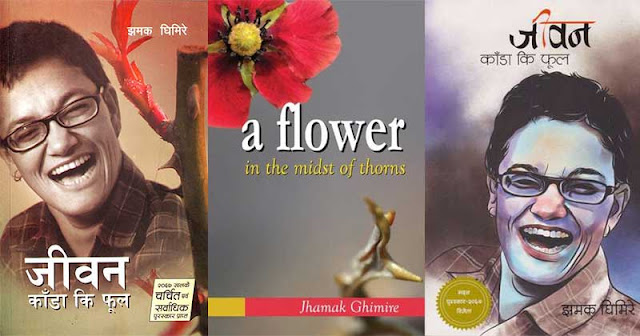PARAGLIDING IN POKHARA: a lifetime experience
Paragliding has come under the scrutiny of the Civil Aviation Authority Pokhara (CAA). The CAA strictly monitors the flying activities of Sunrise Paragliding, Blue Sky Paragliding and Frontiers Paragliding. The CAA has also maintained some code of conduct that all paragliding companies must honor sincerely.
 |
| Goma Gurung, former vice president of the Lion Club of Pokhara Sapta Gandaki, poses a photo with the pilot. Photo: LB Thapa |
By LB THAPA
The valley of Pokhara is endowed with a rich stock of natural beauty. High hills, craggy mountains, cascaded fields, and the Seti River meandering through the heart of Pokhara make the valley one of the most beautiful places in the world. It is one of the suitable places to enjoy holidays for tourists. There is hardly any place in the world that can stand parallel to Mt. Fishtail and Annapurna ranges at the backdrop of Fewa Lake. Great scholars like a Japanese Buddhist monk, Ekai Kawaguchi, and Dr. Toni Hagen, a Swiss geographer, have highlighted Pokhara in their famous books.
The valley is replete with the stock of exotic beauty often regarded as pristine and unique. Whether it is arduous trekking just watching the morning sunrise or boating in the aquamarine waters in Fewa Lake, all fun and pleasures are here. There is still one more thing that pulls scores of visitors to Pokhara from all over the world. And it is paragliding.
Over the last decade, adventure tourism has become extremely popular among the daring tourists in Pokhara. Paragliding can offer unlimited thrills and excitement in the sky for daring people who expect more excitement and fun. The Pokhara Hills are considered to be one of the best places in the world for paragliding. The experience of paragliding over Fewa Lake and nearby mountains is truly wonderful for adventure seekers.
An ideal peak is the first requirement for paragliding. There are some good hills like Sarangkot, Toripani, and Armala but Sarangkot hill (1500m) is preferred more by the adventure seekers. While flying from the Sarangkot hill, one can have a wonderful scenic beauty scattered around. High hills, forests, temples, monasteries, majestic Mt. Fishtail, and above all the impressive Fewa Lake are a few to name which leave a profound impact on all paragliders. Of course, a paragliding flight is a journey through nature where thrill and excitement are assured.
Laxman Kunwar, managing
director cum tandem pilot at Nepal Flying Paragliding School, said, "We
conduct two kinds of paragliding, one is of 30 minutes and another is of 60
minutes. These flights are conducted under the supervision of trained pilots. When
the sky is clear and a few cirrus clouds amble idly through mountains, we
reach onto the top of Sarangkot and get prepared for the flight. A 30-minute
flight is conducted around the Sarangkot hill, Hyangja monastery, Fedi, and
around the Fewa Lake. The short flight is more popular among adventure seekers
as it comes at an affordable price while the long flight is a bit expensive. The 60-minute flight takes paragliders high up in the sky and farther as well.
Paragliders fly over Tibetan refugee camp, Fedi, Pumdi Bhumdi, Kaskikot, around
Mt. Fishtail, World Peace Pagoda and Fewa Lake".
Paragliding has come under the scrutiny of Civil Aviation Authority Pokhara
(CAA). The CAA strictly monitors the flying activities of Sunrise Paragliding,
Blue Sky Paragliding and Frontiers Paragliding. The CAA has also maintained
some code of conduct that all paragliding companies must honor sincerely.
Nepal Flying Paragliding School came into existence only in 2014 but its popularity has soared up dramatically. To a large extent, its credit goes to internationally acclaimed paraglider Laxman Kunwar. He has earned a reputation for being the best paragliding pilot in Pokhara. He is one of the most skilled tandem pilots in Pokhara today. His unflinching service and dedication to popularizing paragliding in Pokhara are praiseworthy indeed.
Rajesh Bomjan is another person in Pokhara whose name is synonymous with paragliding. His unassuming effort to popularize paragliding in Pokhara is
outstanding. Without a doubt, he is Nepal’s first professional paraglider. Biru
Bomjan along with Nabhiyo Elier set up Sunrise Paragliding in 1992. Rajesh
succeeded his father Biru Bomjan and now he rules the roost.
Speaking with this scribe, Laxman Kunwar said: "Over the years,
paragliding has been successful in carving a niche as the most thrilling airborne
sport. As a result, many tourists across the world rush to Nepal for
paragliding. Unfortunately, even after having spent over one decade, the
government has not paid adequate attention to the promotion and development of
paragliding in the country. There is no separate rule or policy to govern
paragliding activities. Speaking frankly the government has completely
neglected the paragliding sector. This is absolutely heartrending for people like
us who are associated with this business by leaving everything behind. Though
there are some problems in running a paragliding business, yet we can hope the
business will have rosy days ahead”.
Parahawking has added a new dimension to Pokhara’s paragliding. More tourists prefer to have a rare experience of parahawking. In parahawking, some birds of prey are trained to fly with paragliders. The parahawking concept was first conceived and developed in Pokhara and was brought into practice in 2001. These birds are trained to fly side by side with the paragliders. And intermittently these birds entertain the paragliders with their natural acrobatics. The birds fly high up in the sky and guide the way through fluttering clouds. These ferocious-looking mighty birds also perch smoothly on hand whenever called by the pilot. The passengers, sitting in front, can caress them, and the next moment they disappear into the patches of thick clouds and pop up from nowhere, leaving you to keep on guessing all the time.
Normally a paragliding flight is conducted in tandem. The only passenger sits in front of the pilot. The pilot handles the paraglider sitting behind the passenger. Only professional pilots with an internationally recognized license can fly the paraglider. The license is duly verified by the authority at the Pokhara Airport and a certificate is awarded.
Nepal Airsports Association
(NAA) has been formed to regulate airborne adventurous sports in
Pokhara. The NAA makes rules and policies that help maintain healthy
competition and avoid confrontation among the paragliding companies.
The life span of a paraglide is short, say three years. But it can be repaired so
that its life can be lengthened. Senior paragliders can do the necessary repairing
work. Serge Benote, a senior French paraglider is popular for repairing the
damaged paraglider. Most of the paragliders are imported from Brazil and
Europe. They are normally available in three sizes i.e. small, medium, and
large. It is the weight of the pilot and passenger that determines the size of the paragliders to be used for the flight.
Goma Gurung, an adventure-loving young woman looked extremely delighted after her memorable flight with Laxman
Kunwar. "It was truly a memorable adventure that I can never forget the
rest of my life. I flew up in the sky and below was all nature’s wonder. I
have no words to explain how things look amazing from a height. Well, I must
admire the pilot for his extraordinary acrobatic skill. It was my first flight
and I was a little nervous, but I knew I was in the safest hands”.
In recent times more paragliding companies have jumped into the business, which has made the sky over Pokhara more unsafe and risky: Laxman Kunwar, managing director and tandem the pilot of Nepal Flying Paragliding School
 |
| Laxman Kunwar, managing director and certified pilot, explains safety measures. Photo: LB Thapa |
Laxman Kunwar is the managing director of Nepal Flying Paragliding School. He is also a certified paragliding pilot. His hard work and dedication have earned him a distinct place and recognition in his profession. Before joining the paragliding business, he was a professional trekker. He spent about a decade in the trekking profession then he decided to try his hand in paragliding. Today, with the dint of hard work and perseverance he has apparently achieved everything that he had dreamed of in his life. There are very few managing directors in the business of paragliding in Pokhara who are also certified, pilots. Laxman Kunwar is undoubtedly one of the most talented and skilled tandem pilots. Laxman Kunwar spends most of his time in tandem flights, while his partner Sovit Baniya, vice president of Nepal Airsports Association (NAA), stays at the office and manages the booking.
The other day LB Thapa spoke with Laxman Kunwar about the future of paragliding and adventure tourism in Pokhara. Excerpt.
You were in the trekking business for a decade. What changed your mind
to jump into the paragliding business?
I would like to interpret it differently. I was in the adventure business and now also I am in an adventure business. So, from this perspective, I have not changed the business. It is as it was before.
What is your experience with the two businesses? Which one is more successful?
My perspective is different. If there is a favorable situation in the country, then all kinds of tourism businesses will flourish. If not then every part of the national economy will receive a blow. This is what now we have been experiencing in every sector.
Unlike other paragliding companies, you have used ‘school’ at the end of
your company name. What does it mean?
In the future, my plan is to run a paragliding school in Pokhara. There I want to train young boys and girls the art and skill of flying a paraglide. Nowadays we don’t have to go abroad to get a pilot’s license. It can be received in Nepal.
In recent times many paragliding companies have come into existence.
What do you think?
To date, there have been 63 paragliding companies registered in Pokhara. As a result, a crowd of paragliding can be seen in the sky over Sarangkot. Now paragliding in Pokhara has become much riskier and unsafe than before.
Why does Nepal Airsports Association (NAA) silent over this matter?
This is beyond my comprehension. NAA must act before it is too late. The sky over Pokhara is enough for about 15-20 paragliding companies, then why there are 63 paragliding companies. I smell a rat in the whole process. Moreover, there are many people who have bribed the authority and registered four or five paragliding companies at the same time. Later they can sell those companies in profit. There are many paragliding owners who know nothing about paragliding…primarily they are real estate brokers. They have money to bribe and corrupt bureaucrats are ever ready to overlook law when they see the money.
How have earthquakes and Indian blockades affected Nepali tourism?
Honestly speaking. The earthquake had only caused a temporary problem for the Nepali tourism sector. The nation was reviving fast from the trauma of the earthquake. However, the Indian blockade has completely destroyed Nepali tourism. You can blame the Indian blockade for the loss and damage of Nepali tourism. Nepali people will never pardon India for its mean act. Now India does not have friendly relations with any country in South Asia. India did not act like a friend with Nepal; it has rather acted more like a foe.
If you want to give a message through our magazine, Food & Wine.
The tourism sector is the backbone
of Nepal’s economy. Every possible effort should be made from all quarters of
life to protect the tourism sector. The tourism sector alone can give adequate support
to many other sectors of the economy. I hope the present crisis in the country
will soon be solved and the country will march ahead. At the same time, I want
to give my sincere thanks to your esteemed magazine for
putting forward my views before the adventure-loving people of Nepal and
abroad.
 |
| LB Thapa is a Pokhara-based freelance writer and author. |









.png)
Comments
Post a Comment